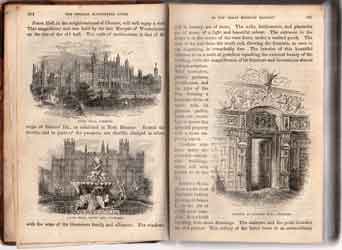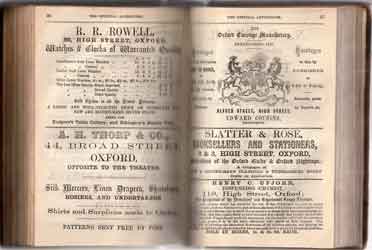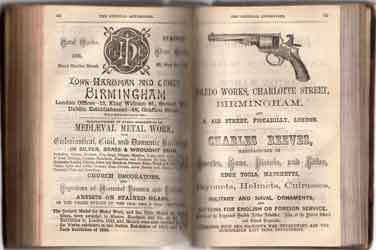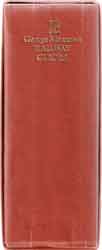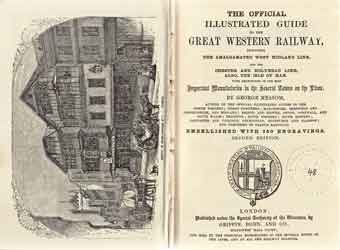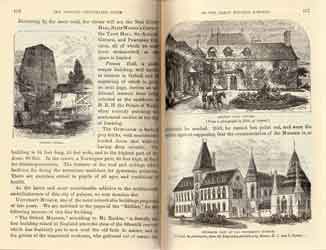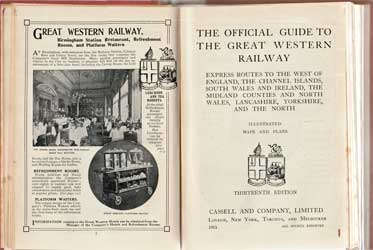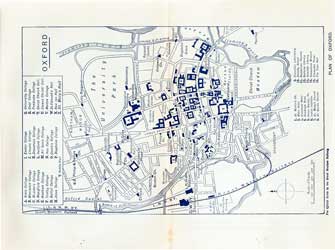Early guides to the GWR
Whilst not commissioned by the Great Western Railway, several early guide books were published. These were generally with the blessing of the GWR, and often contained material supplied by them. As early as 1839, with the line only having reached Twyford, James Wyld's Guide was published and a year later this was followed by Arthur Freeling's Great Western Companion. With London and Bristol finally linked, the first edition of Edward Mogg's Great Western Railway and Windsor, Bath, and Bristol Guide was published in 1841. The first of George Measom's guides appeared in 1852 which was followed by the massive 1860 edition. Cassell & Company published guides for the major railway companies, that for the GWR first appearing in 1884.
With the exception of the Bradshaw's railway timetable publications, all these guide books were mainly topographical in nature and contained many interesting advertisements, local maps and illustrations.
~~~~~~ ooooooOOOoooooo ~~~~~~
Click or tap on any page thumbnail to see a larger image.
~~~~~~ ooooooOOOoooooo ~~~~~~
Bradshaw's railway guides and timetables
Most people are aware of the 'Bradshaw' railway guides due to Michael Portillo's television travel programmes which started in 2009 when he filmed the first series of Great British Railway Journeys. In this, and later series based in Great Britain, he carried and made extensives reference to George Bradshaw's 1863 tourist handbook. The old ticket office at Culham was briefly visited in the first episode of series 12 which first aired on April 26th 2021.
Bradshaw's was a series of railway timetables and travel guide books published by W.J.Adams and later Henry Blacklock, both of London. They are named after founder George Bradshaw, who produced his first timetable in October 1839. Although Bradshaw died in 1853, the range of titles bearing his name continued to expand for the remainder of the 19th and early part of the 20th century. Over the years, several publishers have produced facsimile versions of a number of Bradshaw guides.
Measom's illustrated guides
Possibly less well known are a series of descriptive guides produced about the same time by George Measom. Measom was born in Blackheath, Kent, and during the 1840s he became a skilled engraver and started to produce books illustrated by his engravings. His first railway work was the Illustrated Guide to the Great Western Railway which was published in 1852. His railway books described, sometimes in great detail, the towns, cities and countryside through which the railway passed. More titles followed and by 1867 his combined books covered the entire British network.
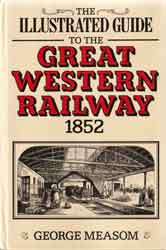
1852 guide - facsimile
We have never come across an original copy of George Measom's first railway guide, but do have this facsimile version from 1985 which was published in both hard and paper back form by Berkshire County Library in association with Countryside Books.
This facsimile of the first guide is just 64 pages long and is embellished with 50 drawings. We would guess that the original also carried many pages of advertisements, similar to the enlarged 1860 edition. The four page introduction gives a brief history of the Great Western Railway and describes the districts through which it passes. Much is made of the superiority of the Great Western trains when compared to those of the 'narrow gauge'. The Didcot to Oxford, Banbury and Birmingham branch is mentioned in the descruptive text, but the line is only described as far as Banbury, with the promise of a continuation to Birmingham in a future edition.
The station at Culham gets the briefest of mentions as 'Abingdon Road Station', as it was then, being about half a mile from the town of Abingdon. This was something of an under estimate as it is almost three miles in reality
1860 edition
A much enlarged guide was published in 1860, comprising two volumes and with the rather long winded title The Official Illustrated Guide to the Great Western Railway, Including the Amalgamated West Midland Line, and the Chester and Holyhead Line, also, the Isle of Man, with descriptions of the most Important Manufactories in the several Towns on the Lines.. It was printed in small octavo format by Reed and Pardon, and published by Griffin, Bohn, and Co. of London.
We consider ourselves to be fortunate in having found an original copy of the second volume. There is no frontispiece in our copy, the first page is numbered 561 and starts part way through the description of Chester. We guess the printer simply divided the pages roughly into two parts when binding. The descriptive pages finish on page 872 but there then follows another 220 pages under the heading Official Advertiser then another four pages numbered 1-4 and finally a fold out final page. Our copy is understandably very delicate and difficult to scan without damaging the book. Just visible on the spine are the letters 'WEST[ern] RAILWA[y]' and a larger number '2'. Some other lettering is very indistinct but looks to include '87' above the 2 and the letters 'AGE' below, could this relate to 872 pages and volume 2. We'd love to hear from any reader who perhaps knows more about this book.
The advertisement section contains many fascinating adverts for businesses and hotels etc. in Oxford. We include the one for the arms manufacturer in Birmingham as a reminder that guns could, at that time, be legally carried. Throughout the Victorian era there was no legal restriction to owning a gun. The Gun Licence Act of 1870 required a person to obtain a licence (from the Post Office) to carry a gun outside his own property for any reason. A licence was not required to actually buy a gun until the Pistols Act of 1903, even then it only applied to handguns. The Firearms Act of 1920 introduced wider ranging restrictions.
1862 edition - facsimile
1862 saw the publication of the two volumes from 1860 combined into a single one which was again published by Griffin, Bohn, and Co. and printed by Reed and Pardon. We have in our collection this facsimile edition published by the Oxford Illustrated Press, blind stamped as being copy 48 of a limited edition. It is undated, but an inscription inside is dated 'Christmas 1974'. This was published, as was the original, in small octavo format and contains in excess of 1000 pages as, in addition to the 800 page first section, there was also a new 280 page second section covering the Bristol and Exeter, North and South Devon, Cornwall, and West Cornwall and South Wales Railways. This section is also noted as being the second edition and having 270 engravings, the two sections are numbered individually but there are no pages of advertisements in this facsimile.
The section covering 'The Branch Line to Oxford' was a trifle out of date even in 1860 when first published as the station at Culham gets the briefest of mentions as 'Abingdon Road Station', and there is no mention of the branch to Abingdon which opened in 1856. The text was taken from the very first guide written in 1852 which predated the opening of the branch and renaming of the station to Culham. Nuneham House and Park does however get a fulsome description.
Cassell's Official Guide to the Great Western Railway
The first edition of Cassell's guide to the GWR was published in 1884 and went on to run into many editions until being discontinued soon after the first world war. These books, whilst containing several hundred pages, were not as voluminous as that of Measom's guide. They were styled as The OFFICIAL GUIDE to the Great Western Railway and were based on information supplied by the GWR who regularly advertised the guide in their penny time books.
1913 edition
This, the thirteenth edition, was edited by Tom Brine and is a fascinating book which contains 488 numbered pages plus supplements covering 'Colonial Government, Shipping, Railway, Banking, Insurance and Investment' (44 pages), 'Public Schools, Preparatory Schools Private Schools, and Education' (10 pages), and 'Great Western Railway Hotels and Refreshment Department' (8 pages). There are many fold-out maps and plans, illustrations and drawings to complement the text. but it is perhaps the many advertisements which provide the best insight into the period.



